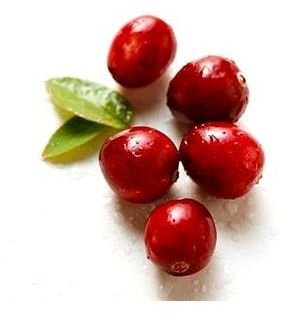Cranberries: Nutritional Facts & Serving Suggestions for the Cranberry
Cranberries: Nutritional Information
The cranberry, a tart, red relative of the blueberry, grows wild on bushes or is cultivated on low vines in swampy ground. Cranberries are packed full of vitamins that can help one avoid urinary tract infections, kidney stones, high cholesterol and even cancer. These powerful berries have also been shown to aid the body in fighting against macular degeneration. In addition, cranberries can help aid in recovery from a stroke, and can help blood vessels to function better.
Recent health studies have revealed the following health results of consuming cranberries:
Cranberry juice is able to can block urinary infections by binding to bacteria, prohibiting that bacteria from adhering to cell walls. When consumed over a number of months, cranberry juice can kill the H. pylori bacteria (which potentially causes stomach cancer and ulcers). Proanthocyanidine, a compound found in cranberries, prevents plaque from forming on teeth: in fact, mouthwashes are being developed with this compound in them! Proanthocyanidine found in cranberries has also been shown to be able to interfere with the production of E. coli bacteria–even strains of the bacteria that have become resistant to conventional treatment–making the E. coli bacteria unable to start at infection in the body!
So, what do cranberries contain that make them so good for your health, enabling them to promise such great benefits for your body and well being?
For starters, cranberries are a good food for dieters, being low in fat and high in nutrition. One half cup of fresh cranberries (about forty-seven grams in weight) contains only 23 calories, but is rich in nutritional elements that the human body needs daily.
Cranberries are an excellent source of vitamin C, dietary fiber, manganese and vitamin K.
Cranberries: Selecting, Storing and Serving
Fresh cranberries are at their peak from October through December, so this is the ideal time to pick or buy fresh cranberries. However, you can buy dried or frozen cranberries–or even cranberry juice or capsules–to benefit from cranberries’ nutritional offerings.
When selecting cranberries, look for berries that are plump, firm and deep red. The deeper color of red the cranberry, the richer it is in vitamins. Fresh cranberries retain the highest amount of nutrition, with dried cranberries in second place and juice in third. When possible, therefore, it’s a good idea to eat cranberries fresh, but is also great to drink them as juice and eat them dried.
Here are some delicious serving ideas for cranberries:
- Make a fruit salad that combines the tart cranberries with sweet fruits such as pineapples, pears, peaches, apples and bananas.
- Make a fresh fruit smoothie by whipping up the following in your blender: half a banana, a large dollop of yogurt, a handful of cranberries, a handful of strawberries, a splash of orange juice and several ice cubes.
- Add dried cranberries instead of raisins to your oatmeal, breads, muffins, salads…even cookies!
- Combine unsweetened cranberry juice with grape juice or apple juice for some natural added sweetness.
